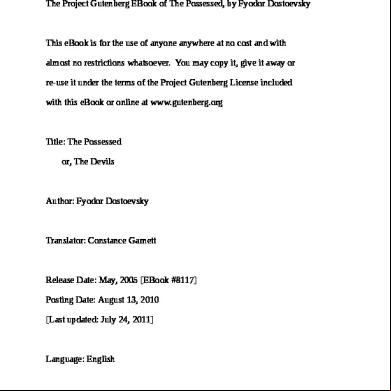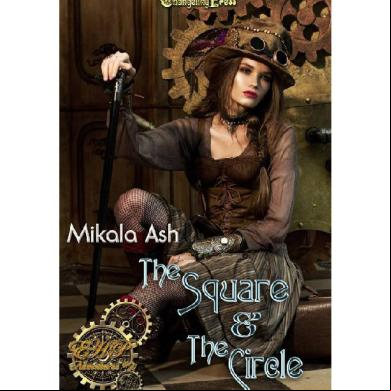The Panolong 5h1z2o
This document was ed by and they confirmed that they have the permission to share it. If you are author or own the copyright of this book, please report to us by using this report form. Report 3b7i
Overview 3e4r5l
& View The Panolong as PDF for free.
More details w3441
- Words: 1,488
- Pages: 6
THE PANOLONG: ART CRITIQUE The Panolong is a house ornament fashioned by the Maranao people. Panolong is a part of the beam in the Maranao house. The shape of the Panolong is an architectural translation of a “prow”, meaning the potruding part in the front of a ship. Panolongs were designed to make the house appear as a floating boat in the eyes of the viewer. The Cultural Center of the Philippines Museo ng Kalinangang Pilipino showcased Panolong in its museum. Panolongs follows two design concepts in its design, a floral like/ vine like design and a design which resembles the image of the “naga” also known as the serpent. Unfortunately the museum holds no naga – based conceptualization of the Panolong as of the moment. As I looked on the three Panolongs displayed I picked the one in the middle, it is a vine like design of Panolong. The sculpted piece was a medium – sized decoration. The wooden carving is almost a meter in width and about quarter of a meter in height, a wooden carving from polychormed wood. Chisel was the tool used to achieve the roughly finished art. The texture of the Panolong is simply wooden texture since it was basically carved out from wood. The impression of Panolong in my eyes is a plain right triangle, geometric in shape and projects a neat but not an edgy perimeter. Panolongs basically comes in the color of the wood , which is brown but according to the museum guide during the vernacular times it was painted with bright colors, green, red or yellow. Looking at the aesthetic quality of Panolong your eyes will really be pulled by the movement of the vine patterns the lucid lines, the expression of Maranao’s cultural prosperity at that time, the early times. One of the most distinct qualities of the Panolong is the blend of straight and curved carvings. The vines which appear to be sprawling along with the triangular boundary it is in. I think the idea behind this wooden carving is the love of Filipino’s for nature and environment. The imitation of our built surroundings, it was once said that; “Architecture is nothing but an imitation of nature.” Through this idea it is amazing to recognize that in the past our ancestors have already thought of it. Consequently I think the purpose of Panolong as a whole is to show how great the Maranaos as sea mans, the group of the created the Panolongs to display a floating boat parody in their settlements. According to Architect Leandro Locsin “the Maranao house seems to float because of its boat – influenced design of protruding beams”. The anthropologist Jesus Peralta says, that since Lanao is frequently visited by earthquakes, Maranao houses rest on floating s through large boulders beneath their houses. With all this being said I think this artwork is successful in its exhibition in the minds of the viewers as most people, me in particular share
this conviction within. I can say that Panolongs made an important contribution to art history. Let us through the lines above it promotes culture. Of all the ethnicity of the vernacular houses of the Philippines the Maranao Panolong stands out. This craftsmanship is unique and has no existing imitation. It has been said that “a country without a culture is a country without a future.” A good starting point for development is to evaluate our own culture. Architects must never be oblivious of culture because being mindful of the culture is needed to produce a sensuous, intellectual and functional unit of order. THE AKUSAN; “The Amulet”: ART CRITIQUE The Akusan from Bontoc, Mountain Province, worn by women to serve as amulets. An amulet can be any object but its most important characteristic is its alleged power to protect its owner from danger or harm. Amulets are different from talismans as a talisman is believed to bring luck or some other benefit, though it can offer protection as well. Amulets are often confused with pendants charms that hang from necklaces any given pendant may indeed be an amulet, but so may any other charm which purports to protect its owner from danger. This artwork symbolizes adorn for the women of Ifugao living in Bontoc, Mountain province. The Akusan is like a tower of beads at first glance. This amulet from the vernacular times is as long as the mid-section of the average human body. The Cultural Center of the Philippines Museo ng Kalinangang Pilipino exhibits one in a glass frame along with some Ifugao sculptures. Also don’t be mistaken that at first glance you only consider “beads” as the entire make-up of the artwork. Akusan is a mix- up of ivory, rattan, shell, cloth, stone and beads. Truly indigenous in nature, but it is an elegant fashion and could still fit in up – today. Just like Panolong the one discussed earlier, Akusan is contingent to its materials. The color, texture, and shape will all be dictated by the material. This piece of artistry is mostly dominated by color beige. Akusan has somewhat symmetry, for me it has balance especially when you focus on the arrangement of beads and stones, etc. The harmony of objects used brought out the unity it possesses. The first thing that caught my attention was the bulk at the very bottom of the amulet. I am very considerable especially with small details that can mean a lot in the entire artwork. Akusan poses not much movement as it is just plain beads arranged artistically, but I think the idea and mood expressed this time is the early Filipinos beliefs. The Philippines is one of the countries in the whole world that flourished in the field of religion and spiritual beliefs. The purpose of amulets varies considerably according to their time and place of origin. In many societies, religious objects serve as amulets. According to folklore, the most powerful anting-anting is the hiyas ng saging
The hiyas must come from a mature banana and only comes out during midnight. Before the person can fully possess this agimat, he must fight a supernatural creature called kapre. Only then will he be its true owner. During holy week, devotees travel to Mount Banahaw to recharge their amulets. In general I think Akusan didn’t make much of a contribution in the Philippine art history, but I think it is successful with its purpose. The Akusan won’t be in the museum if it is not entirely important. It still contributes in our history , it shows that just like Greece and Rome during the past we are already civilized before the coming of the colonizers that branded us, as “indios” or already incapable of civilization. Just like them we believe that there are supernatural beings out there and a supremacy of all creation.
__________________________________ E N D___________________________________
ARTIST BIOGRAPHY: PANOLONG: MARANAO People: Maranao Artisans The Maranao inhabit Lanao del Norte and Lanao del Sur in Mindanao. The name Maranao translates to mean “People of the Lake”, after their traditional territory in the area surrounding Lake Lanao in the Bukidnon-Lanao Plateau.According to the early written genealogical documents salsila, this term generally referred to the native people living around Lake Lanao. The lake area is the home-range of the Maranao which is located in North Central Mindanao, approximately 135 sq. miles in area and is situated 2,300 feet above sea level. They are one of the largest Islamic groups in the Philippines, with the core areas being Marawi City, Lumba-abayabao, and Bayang. The Maranao are a splinter group of the Maguindanao who took up Islam; families tracing their religious origins to Sharif Kabunsuan, who introduced the religion to the region. Communities are clustered around a mosque and a torogan, a royal house belonging to the preeminent economic household in the area. Aside from exotic textiles, metalwork, and woodcraft, the torogan structure is the most significant and spectacular example of Filipino secular architecture. As a people, the Maranao are widely distributed and contribute significantly to the market and trade industry. For instance, the awang (dugout boat) used principally in Lake Lanao is both unique and extremely ornate. Textiles, on the other hand, symbolize the socio-economic rank of the wearer through the intricacies of the design motifs woven into the fabric, as well as, the richness of the colors used. AKUSAN: Ifugao People: Ifugao artisans: The Ifugao people were the tribes located in the Norhern part of the Philippines. The Mountain Province.
Reference: http://www.ethnicgroupsphilippines.com/people/ethnic-groups-in-the-philippines/maranao/
RESEARCH WORK: PANOLONG:
The panolong flaring out from the beams is the most arresting feature of the torogan. Its okir carving usually features the naga or serpent as well as floral and star-and-bud motifs. Panolong is a wing like design of a vernacular house in maranao called torogan.
AKUSAN: Philippines | Akusan (woman's belt) Bontoc. Conus shells, coiled brass, woven cotton fabric, human bone. Early 20th century.
REFERENCE: http://digitaleducation.net:8080/CM/panolong C Website
this conviction within. I can say that Panolongs made an important contribution to art history. Let us through the lines above it promotes culture. Of all the ethnicity of the vernacular houses of the Philippines the Maranao Panolong stands out. This craftsmanship is unique and has no existing imitation. It has been said that “a country without a culture is a country without a future.” A good starting point for development is to evaluate our own culture. Architects must never be oblivious of culture because being mindful of the culture is needed to produce a sensuous, intellectual and functional unit of order. THE AKUSAN; “The Amulet”: ART CRITIQUE The Akusan from Bontoc, Mountain Province, worn by women to serve as amulets. An amulet can be any object but its most important characteristic is its alleged power to protect its owner from danger or harm. Amulets are different from talismans as a talisman is believed to bring luck or some other benefit, though it can offer protection as well. Amulets are often confused with pendants charms that hang from necklaces any given pendant may indeed be an amulet, but so may any other charm which purports to protect its owner from danger. This artwork symbolizes adorn for the women of Ifugao living in Bontoc, Mountain province. The Akusan is like a tower of beads at first glance. This amulet from the vernacular times is as long as the mid-section of the average human body. The Cultural Center of the Philippines Museo ng Kalinangang Pilipino exhibits one in a glass frame along with some Ifugao sculptures. Also don’t be mistaken that at first glance you only consider “beads” as the entire make-up of the artwork. Akusan is a mix- up of ivory, rattan, shell, cloth, stone and beads. Truly indigenous in nature, but it is an elegant fashion and could still fit in up – today. Just like Panolong the one discussed earlier, Akusan is contingent to its materials. The color, texture, and shape will all be dictated by the material. This piece of artistry is mostly dominated by color beige. Akusan has somewhat symmetry, for me it has balance especially when you focus on the arrangement of beads and stones, etc. The harmony of objects used brought out the unity it possesses. The first thing that caught my attention was the bulk at the very bottom of the amulet. I am very considerable especially with small details that can mean a lot in the entire artwork. Akusan poses not much movement as it is just plain beads arranged artistically, but I think the idea and mood expressed this time is the early Filipinos beliefs. The Philippines is one of the countries in the whole world that flourished in the field of religion and spiritual beliefs. The purpose of amulets varies considerably according to their time and place of origin. In many societies, religious objects serve as amulets. According to folklore, the most powerful anting-anting is the hiyas ng saging
The hiyas must come from a mature banana and only comes out during midnight. Before the person can fully possess this agimat, he must fight a supernatural creature called kapre. Only then will he be its true owner. During holy week, devotees travel to Mount Banahaw to recharge their amulets. In general I think Akusan didn’t make much of a contribution in the Philippine art history, but I think it is successful with its purpose. The Akusan won’t be in the museum if it is not entirely important. It still contributes in our history , it shows that just like Greece and Rome during the past we are already civilized before the coming of the colonizers that branded us, as “indios” or already incapable of civilization. Just like them we believe that there are supernatural beings out there and a supremacy of all creation.
__________________________________ E N D___________________________________
ARTIST BIOGRAPHY: PANOLONG: MARANAO People: Maranao Artisans The Maranao inhabit Lanao del Norte and Lanao del Sur in Mindanao. The name Maranao translates to mean “People of the Lake”, after their traditional territory in the area surrounding Lake Lanao in the Bukidnon-Lanao Plateau.According to the early written genealogical documents salsila, this term generally referred to the native people living around Lake Lanao. The lake area is the home-range of the Maranao which is located in North Central Mindanao, approximately 135 sq. miles in area and is situated 2,300 feet above sea level. They are one of the largest Islamic groups in the Philippines, with the core areas being Marawi City, Lumba-abayabao, and Bayang. The Maranao are a splinter group of the Maguindanao who took up Islam; families tracing their religious origins to Sharif Kabunsuan, who introduced the religion to the region. Communities are clustered around a mosque and a torogan, a royal house belonging to the preeminent economic household in the area. Aside from exotic textiles, metalwork, and woodcraft, the torogan structure is the most significant and spectacular example of Filipino secular architecture. As a people, the Maranao are widely distributed and contribute significantly to the market and trade industry. For instance, the awang (dugout boat) used principally in Lake Lanao is both unique and extremely ornate. Textiles, on the other hand, symbolize the socio-economic rank of the wearer through the intricacies of the design motifs woven into the fabric, as well as, the richness of the colors used. AKUSAN: Ifugao People: Ifugao artisans: The Ifugao people were the tribes located in the Norhern part of the Philippines. The Mountain Province.
Reference: http://www.ethnicgroupsphilippines.com/people/ethnic-groups-in-the-philippines/maranao/
RESEARCH WORK: PANOLONG:
The panolong flaring out from the beams is the most arresting feature of the torogan. Its okir carving usually features the naga or serpent as well as floral and star-and-bud motifs. Panolong is a wing like design of a vernacular house in maranao called torogan.
AKUSAN: Philippines | Akusan (woman's belt) Bontoc. Conus shells, coiled brass, woven cotton fabric, human bone. Early 20th century.
REFERENCE: http://digitaleducation.net:8080/CM/panolong C Website










